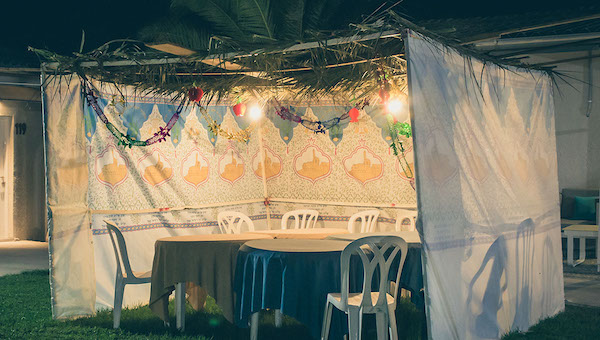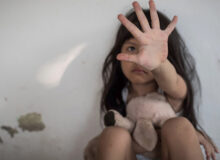Sukkot is one of the three most important Jewish festivals (the other two are Passover and Shavuot). Those three holidays are commanded in the Torah. Some of you are thinking, “hey, what about Chanukah?” Minor festivals such as Purim and Hanukkah were created by ancient Rabbis. So they are not as important. The other major Jewish festival, my birthday, which was created by a diabetic Jewish blogger looking for an excuse to have ice cream cake. Sukkot Sukkah
It is important to note that the five-day period after Yom Kippur leading up to Sukkot is the Jewish calendar’s most dangerous day. Those days aren’t hazardous because God starts zapping those who didn’t make it into the book or iPad of life on Yom Kippur. It’s dangerous because that’s the one time each year some Jewish men use tools to create a Sukkah (a hut that has nothing to do with Jabba).
As you can see in the picture above. A Sukkah is a flimsy hut built for the Holiday. How flimsy? Imagine if Ikea made houses—a Sukkah is much more fragile than that One purpose of the Sukkah is to remind Jews of the way they lived when Moses was leading them through the desert wilderness. It took 40 years because, as Mrs. Moses, whose name was Zipporah complained, not once did he stop at the ancient equivalent of a gas station to ask for directions.
Sukkot is also known as the Festival of Booths. That term caused much Antisemitism during the second half of the 19th century because some Americans believed the name the Festival of Booths meant that the Holiday was a celebration of President Lincoln’s assassin. It’s a happy holiday. Some of its other names are Yom Simchateinu (the day of our rejoicing) or Z’man Simchateinu (the time of our rejoicing). Our happiness has nothing to do with the fact that we are allowed to eat after fasting on Yom Kippur. Nor is it that we’ve been able to put down our hand tools without significant damage to our bodies (sometimes).
As mentioned above, Jews aren’t great with tools. For many of us (like yours truly), the last time we picked up a tool or climbed up a ladder was last year’s Sukkot. If you peek out your window and watch a Jewish neighbor build their Sukkah, make sure you have no food in your mouth. You will probably snort, or belly laugh your food out your nose. Building a Sukkah is the construction version of the “Keystone Kops” (only funnier).
If the annual building project is proceeding horribly, some of the builders can be heard screaming about their failure in strange tongues. Last year my neighbor Larry, a huge Star Trek fan, hit his thumb with a hammer and screamed, “vaj ghorDu’, which is Klingon for “oh crap, that hurts.” My friend Ed screamed, “ó cacamas a ghortaíonn” the exact phrase as Larry’s but in Irish. Ed is not Jewish. He’s an observant Catholic and has never built a Sukkah. His Irish scream was just to show sympathy for his Jewish friends.
A Sukkah must have a semi-see-through roof built from something that grows in the ground (NO, not cannabis). That roof is called sechach, a beneficial word. The Holiday occurs at the beginning of the fall. Jews eat their meals in the Sukkah (some will even sleep there). Saying the word sechach over and over during the Holiday allows us to politely clear our throats from early fall congestion without appearing to cough up a loogie (in Hebrew משתעל ליחה).
One reason for living in a flimsy hut with a see-through roof is to remind Jews how they lived in the wilderness after being freed from slavery in Egypt. We are reminded that in those ancient times, just as today, the frailty and transience of Jews depended on God. Our dependence on God is necessary to protect us.
My friend Eddie is a rare American Jew. He’s good with tools. Eddie builds his Sukkah from scratch using raw materials. He is what’s known in Hebrew as להשוויץ בגדולות, which translates as ” big show-off.” My other friends (including me) put together a pre-fabricated Sukkah, which sadly doesn’t save my fingers from injury when trying to pound the metal frame together.
By the way, do you want to know how some Jews get lights for our Sukkahs? Have you ever gone into a Walmart 2-3 weeks after Christmas? The stores sell left-over Christmas lights for $1.99 a case? The guy in the parking lot wheeling an extra-large shopping cart filled with boxes of Christmas lights might very well be a Jew who bought them to light the Sukkah. That’s why some say that Sukkot is the one Jewish Holiday with the “Christmas Spirit.”
.

A Lulav
An essential part of the Sukkot celebration is the Lulav, and the Etrog, also known as the four species. The Lulav is a palm branch, joined with myrtle and willow branches (see above), and the Etrog is citron fruit. It kind of looks like a lemon that suffers from boils. The four species are held and waved during various parts of the Sukkot services.

The Very Ugly Etrog Fruit
A favorite part of Sukkot is inviting friends over and hanging out in the Sukkah. It’s less pressured than friends coming into the house to hang out. If we drop something in a Sukkah, it doesn’t matter. We are outside. If something gets dropped, who cares—we’re outside.
BTW if you are invited to hang out in a Jewish friend’s Sukkah, please don’t say you are celebrating “nomadic hut appreciation week.” It’s really not nice.
Speaking of guests, there is a tradition called ushpizin. In this mystical tradition from the Kabbalah, we invite a different biblical hero to be a guest in our Sukkahs each night of the Holiday. The list of guests are Abraham, Isaac, Jacob, Moses, Aaron, Joseph, and David. I suspect we don’t invite the Prophet Elijah to visit because he is still nursing a hangover from Passover. Elijah visits every Seder in every house worldwide to have a glass of wine.
When your friends come to your Sukkah, generally they bring flowers, wine, desserts, etc., The ushpizin biblical guests bring nothing, so don’t expect anything. On the other hand, they don’t eat anything either.
Sukkot is also a holiday that reminds us of the Jewish connection to Israel. We spent forty years living in those flimsy structures, trying to get to the holy land. The newly freed Jewish slaves knew that they belonged in the holy land. In modern times Jews only live in those huts one week every year, but we should also remember the goal of those forty years of wandering was to return to the holy land that Jacob and his sons left two hundred and ten years before. They weren’t called Zionists back then, but that’s what they were.
Sukkot has other significant meanings. Perhaps the best one for today’s world is that on Sukkot, we also pray for the rest of the world. Considering how the world’s looked lately, that’s a good thing. In Biblical times, the High Priest sacrificed 70 bulls during Sukkot. This represented one prayer for each of the 70 other nations of the world. I would imagine that the period before Sukkot was also a period of prayer for the 70 bulls about to be sacrificed.
BTW some historians believe that the first Thanksgiving was modeled after Sukkot.
From building the Sukkah and “living in it for a week to tearing it down, Sukkot is a fun, joyous time we share with family and friends, both Jewish and Gentile.
The last two days of the Holiday are Shemini Atzeret and Simcha Torah.
Shemini Atzeret celebrates our love for God and his relationship with the Jewish people. It adds a special prayer for rain (Geshem). The rain prayer is for the holy land. As it’s not needed here in the US because, during Sukkot, there is usually a strong rainstorm/windstorm that blows our Sukkah from our patio onto its side in the grass. Perhaps it’s God’s way of making all Jews feel like the 2022 NY Mets—blowing success at the last minute.
Simcha Torah is more of a fun day. Jews read the last chapters of the Torah and then the first chapters.
SPOILER ALERT: Before we continue, you should know that the Torah ends with Moses dying.
Judaism teaches that studying Torah is a continual life-long process. That is why on Simcha Torah, we read the last chapter of the Torah (the death of Moses), then immediately rewind the Torah scroll and read the creation story at the beginning of the Torah.
Simcha Torah is a fun gala where we sing, dance with the Torah Scrolls, wave flags, etc. (and drink).
This year allow me to suggest that everyone, no matter their faith, join us in praying for the safety of all the people in the world
As we say in Hebrew: Chag Samayach!
חג שמח
Whether you are Jewish or Gentile, Have A Joyous Sukkot.
https://www.facebook.com/jeffrey.dunetz
Sukkot Sukkah
Sukkot Sukkah
Sukkot Sukkah
https://lidblog1.wpenginepowered.com
gentiles guide Sukkot
gentiles guide Sukkot
gentiles guide Sukkot
gentiles guide Sukkot






